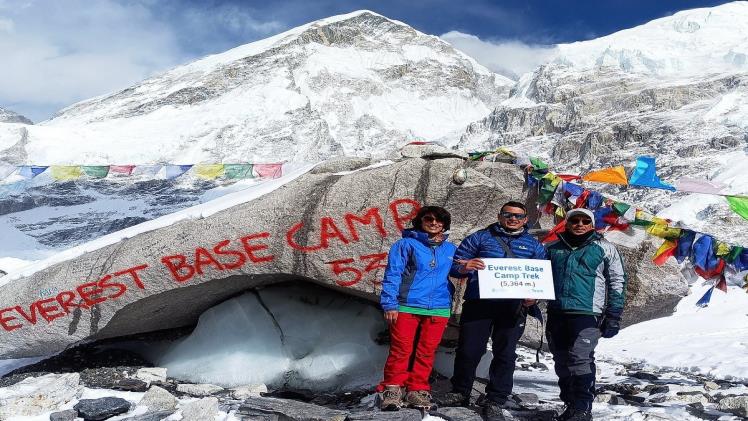Nepal Everest: Base Camp Trek

Considered one of the most coveted, iconic treks in the world, Nepal’s Everest Base Camp Trek will take you on a journey through the highest mountain range on Earth. Guiding it through the heart of the Himalayas: To experience views of the world’s tallest mountain, Mount Everest, in this amazing journey. The trek, however, is more than just a means of reaching the base of Everest; it’s an opportunity to dive into the culture, landscapes, and atmosphere of Nepal’s Khumbu region. From verdant green valleys to dry tundra, and high desert, each stage of the trek reveals stunning scenery that makes every mile a memorably logistically daunting experience.
The journey usually starts with a flight from Kathmandu to Lukla, a small town in the mountains. Even the landing in Lukla is a little heart-pumping, with a short runway situated on a mountaintop. Starting in Lukla, trekkers make their way to Phakding and then to the crowded town of Namche Bazaar, known as the gateway to the Everest region. Trekkers pass through wonderful Sherpa villages on the way, each revealing something unique about the way of life of the local people. The Sherpas, known for their skills on the mountain and their hospitality, are the backbone of the adventure, providing guidance, assistance, and a window into the culture.
Trekkers spend a couple of days in Namche Bazaar to acclimatize, hiking to higher altitudes and returning to the village to sleep. Climbing gradually allows the body to acclimatize to the increasingly thin air, minimizing the potential for altitude sickness, which is one of the most common threats at altitude. Following Namche, the trail leads to Tengboche, where the famous Tengboche Monastery is located; a spiritual center that offers trekkers a deep sense of peace and connection to the peaks. The monastery sits amid snow-clad peaks and provides breathtaking views and a glimpse of Buddhist prayer rituals that give context to the region’s spiritual grounding.
The ascent continues from Tengboche up to the village of Dingboche where only an acclimatization day is spent before heading on to Lobuche, a small tiny settlement that marks a big step in the trek. As the trekkers climb to altitudes that become even more arid, glaciers, serrated peaks, and the bare beauty of the Himalayan backdrop surround them. From Lobuche, trekkers head to Gorak Shep, the last stop before Everest Base Camp. About this place: Gorak Shep is a high-altitude settlement where trekkers rest before making their final push toward the famous base camp.
Reaching Everest Base Camp is grueling but so fulfilling. Frequenters of the mountain stare up at the top of the world, looking up through Everest and its accompanying peaks. The base camp itself, typically also filled with tents for mountaineers seeking to summit, is a bustling, colorful scene, especially in spring and autumn trekking seasons. The moment when their feet touch the Everest Base Camp is a source of great pride and satisfaction for trekkers who worked hard for days to get there.
The Everest Base Camp Trek is not only a challenging trek physically but also offers a diverse range of cultures. The Sherpa villages along the way are filled with tradition: colorful monasteries, Buddhist flags and the sound of Buddhist mantras surround you. Hiking in the Himalayas brings a large opportunity to experience the distinctive relationship of the Sherpa people with the peaks and their hospitality and community. The journey itself, the ups and downs, physical strain, breathtaking beauty at every turn—it is not about getting somewhere.
Ultimately, you can understand that, Nepal’s Everest Base Camp Trek is an adventure of a lifetime. It is a grind both physically and mentally, but it is also filled with unmatched scenery, culture, and reward. Regardless of whether you are an experienced trekker or a new trekking adventurer, walking in the foothills of Mount Everest will inevitably have a lasting impact on your soul, which is why Everest Base Camp Trek is a dream of many people around the world.
Everest Base Camp Trek in Nepal: An Introduction
Everest Base Camp (EBC) trek in Nepal is one of the most sought-after and famous trekking experiences across the globe. This trek, which takes you into the heart of the Himalayas, will take the adventurer right to the foot of Mount Everest — the highest point on our planet. The trek takes you through diverse terrains, floating between lush valleys, dense forests, and the rugged, high-altitude landscapes. Trekkers also mix with Sherpa villages, Buddhist monasteries, and beautiful views of the Himalayan range. In addition to being a physical undertaking, the trek is a cultural experience that invites trekkers to immerse themselves in the rich traditions of the Sherpa people, the indigenous residents of the region. The EBC trek offers an unforgettable experience with breathtaking scenery, a feeling of accomplishment, and a greater appreciation for nature, whether you’re an avid mountaineer or an occasional walker. This is a 12 to 14-day journey that allows trekkers to slowly acclimatize to the high altitudes and beautiful surroundings. Earn a Lifetime Experience with Everest Base Camp Trek for Adventure SeekersNepal has been a dream destination for adventurous enthusiasts.
Trekking into Everest Base Camp: No Place Like It
Everest Base Camp trek accommodation Geographically and culturally, Everest Base Camp is of great importance. Set at a height of 5,380 meters (17,600 feet), it is the base for climbers aiming to reach the summit of Mount Everest, it is one of the most recognizable places in the mountaineering industry. For trekkers, touching base at EBC is a great achievement as it represents standing at the foot of the highest peak on the planet. The significance of EBC, however, extends beyond just its geographical location. Allowing for an alternative to traditional mountain expeditions, the trek to base camp offers an opportunity to appreciate the Sherpa people’s vibrant culture and their synergistic connection to the mountains that they inhabit. As trekkers make their way along the route, they are treated to Buddhist monasteries, the waving of prayer flags, and centuries-old traditions that have remained unchanged. Getting to base camp is a physical challenge and test of endurance, but what you return with is more than a sense of accomplishment. Seeing the towering Everest up close, framed by glaciers, towering snow-capped peaks, and the vast expanse of the beautiful Himalayas, feels settling, awe-inspiring, and ultimately fulfilling. The hike also bestows upon trekkers a profound spiritual connection, since numerous have started to see Everest as a holy mountain. My conclusion: Everest Base Camp is not only a destination, but a journey with multiple personal, cultural, and possibly spiritual weight.
When to Trek the Narrows the Right Way
FAQ-Everest Base Camp Treks Choosing the Perfect Time to Trek Everest Base Camp The ideal months to visit are during the pre-monsoon (spring) and post-monsoon (autumn) seasons, usually from March to May and from September to November. For these months, the weather is most stable and calmest with unambiguously blue skies, mild temperatures, and very negligible amounts of precipitation or snowfall. Spring especially is a popular time to hike, when the days are warmer and the landscapes are vibrant with blooming flowers. In autumn, however, you have crisp air and clear views of the mountains. Both seasons offer trekkers stunning views of Everest and the surrounding peaks without the severe cold or heavy snows found in winter. Though the weather is more reliable then, these months also mark the busiest seasons, and the route can be crowded (especially at popular points like Namche Bazaar). Winter (December to February) and the monsoon season (June to September) are often not recommended for the Everest Base Camp trek. The harsh winter temperatures can be uncomfortable and treacherous, while the monsoon brings heavy rains that make trails slippery and trigger landslides.
Planning Your Trek: What to Expect
Everest Base Camp trek altitude There are many things that you need to consider while planning your Everest Base Camp trek to have a successful journey. The actual hike normally takes 12 to 14 days, factoring in acclimatization days to become accustomed to the high altitude. You’ll start off with a flight from Kathmandu to Lukla, and then trek to Phakding and then to Namche Bazaar. As such, Namche is an acclimatization stop for trekkers, who are encouraged to take short hikes to higher-altitude areas before coming back down to the town to rest. From Namche, the journey continues through Tengboche, Dingboche, Lobuche, and Gorak Shep until arrival at the much-anticipated Everest Base Camp. Each of these stops is a segment of the gradual climb, enabling trekkers to acclimate to the thinning air. You will be trekking between 5 to 7 hours a day on different terrain, some days will be steeper and more difficult and others will be moderate walking. As you trek to EBC, you are also treated to spectacular views of Everest, Lhotse, Nuptse, and other famous peaks of the Himalayas. You need to include rest days for acclimatization, as high-altitude trekking can cause altitude sickness if not managed correctly. But with such a physically demanding journey come the rewards—spectacular landscapes, cultural encounters, and a deep sense of achievement. It’s also important to plan properly by getting permits, and insurance, and securing a guide in order for the trek to be safe and run smoothly.
FITNESS AND PHYSICAL PREPARATION FOR THE TREK
Thus, the right physical preparation is vital if you want to have a successful Everest Base Camp trek. The trek itself requires several hours of hiking each day, often at high altitudes, over steep climbs and rugged terrain. For this reason, you will want to increase your cardiovascular endurance and leg strength in the months before the trek. These include hiking, running, cycling, swimming, etc to build the capacity for endurance and holistic development of the body. Work on aerobic capacity, and strength training to prepare your legs for long periods of uphill and downhill on the trail. Hiking with a fully loaded backpack is another decent option to emulate the conditions of the adventure. It’s important to increase your endurance through longer hikes on different kinds of terrain. Just as significant is developing your core strength and flexibility, because a robust core contributes to balance and mitigates injury risk. Given that the trek to Everest Base Camp is done at high altitude, it’s also wise to train at higher elevations, if you can, so your body can adjust to the decreased oxygen level in the air. Mental preparation is equally as important. Altitude trekking is taxing on the body and the mind, so keeping a positive attitude, pacing oneself, and setting little goals will help keep you motivated. Having physical and mental fitness will ensure you are ready for the lifecycle that the Everest Base Camp trek demands.
Packing and Essential Gear Guide
Assembling the right gear to take on the Everest Base Camp trek is key to being comfortable and safe on the trek. The weather is changing all the time, and trekkers get that experience in different conditions as they gain altitude. Good trekking boots are one of the most critical items on your list, they need to have a waterproof feature, and solid ankle support for the uneven terrain. Clothes are all about layering. Begin with moisture-wicking base layers, then add insulating mid-layers like fleece or down jackets and, on top, a waterproof, windproof shell to shield you from rain and snow. They make teahouses high in the Himalayas, but a good sleeping bag that remains good for 0° is an extreme necessity. A light, durable backpack will also be necessary to haul your essentials with you, and trekking poles to enhance stability on rocky or steep trails. Also, take plenty of water and snacks, a good sunscreen, lip balm with UV protection, and a first aid kit in case of emergencies. UV-protected sunglasses are essential, as sunlight at high altitudes can be harsh on your eyes. A headlamp along with spare batteries and a way to charge devices are essential as well. If you are trekking at higher altitudes, you may also find it useful to have your own personal medical kit, with altitude sickness medication, etc. Finally, do not forget a camera to capture the stunning views while you hike! With proper packing and careful consideration travelers can achieve an exciting and safe trek to Everest Base Camp.
Guide to the Trekking Path
Everest base camp (EBC) trek is a popular and well-established trekking route located in the Khumbu region of Nepal, offering the trekkers both a visual treat and a challenging climb. The adventure usually starts with an airplane ride from Kathmandu to Lukla, a tiny mountain airstrip serving as the official beginning of the trek. The trek from Lukla follows the Dudh Koshi River, through Phakding and Jorsalle. Trekkers now trek ahead leaving behind the last of downhill trails and start summiting the upward trail towards Namche Bazaar, the gateway to the Everest region. Namche itself is a great acclimatization stop, with spectacular views of the surrounding peaks, including the iconic Ama Dablam. The path extends through Namche to Tengboche, finally arriving at the famed Tengboche Monastery, while boasting stunning views of Everest and other gigantic peaks. As hikers ascend, the trail grows steeper and rougher, and high-altitude villages like Dingboche, Lobuche, and Gorak Shep provide rest stops. The hike is done in stages for better acclimatization as trekkers gradually become accustomed to the reduced levels of oxygen as they near Everest Base Camp. Once trekkers arrive in Gorak Shep, they make the last ascent to reach Everest Base Camp, where they get a site of the Khumbu Icefall and the prominence of Mount Everest. The trek is a steady ascent, planned for proper acclimatization, allowing trekkers to approach altitude and enjoy beautiful views along the way.
Acclimatization and How to Manage Altitude Sickness
Acclimatization is key to the success of the Everest Base Camp trek weather, as the high altitude can trigger altitude sickness if not properly managed. When you climb to higher altitudes, air is thinner, and it’s increasingly difficult for your body to receive sufficient oxygen. Altitudes that start from about 2000m above sea level produce different effects on the human body, so people who are trekking there need to go gradually up, take box-sized rests (as they need to get their body to adjust to it) and there are various levels of oxygen that the body can borrow from the atmosphere to adapt. The general guideline is to gain no more than 300–500 meters of altitude per day and to rest at strategic locations such as Namche Bazaar and Dingboche to acclimatize. On such rest days, the trekkers can do short hikes to somewhat higher elevations and then return to their lodges to aid their bodies in adaptation. Mild symptoms of altitude sickness include headaches, nausea, dizziness, and fatigue. If this happens (and it happens sometimes), you should descend to a lower altitude immediately. Hydration is key, too, because dehydration can compound altitude sickness. Highly recommend trekking with a guide who knows the signs and treatment of altitude sickness. With proper acclimatization, hydration and listening to your body, most trekkers experience little to no inconvenience with altitude sickness, allowing them to achieve the trek safely.
Trek Highlights: Amazing Views and Monasteries
With some of the most contrasting scenic views in the world, the trek to Everest Base Camp. Even once trekkers start heading up towards Everest Base Camp itself, they are rewarded with incredible panoramic views of the world-famous mountains of EVEREST, LHOTSE, MAKALU, and CHO OYU. The path traverses a broad swath of terrain, ranging from lush forests of rhododendrons and pine trees to the stark, barren beauty of the high Himalayas. The viewpoint of the Khumbu Icefall from Everest Base Camp itself is one of the chief highlights. The trail is also dotted with several traditional Buddhist monasteries along the way like the renowned Tengboche Monastery which not only serves as a place of worship but also provides breathtaking views of the nearby mountains including Mount Everest. These monasteries offer a window into the profound relationship the Sherpas have with the mountains. One of the best things about the trek is crossing various suspension bridges over the Dudh Koshi River with views down, and the other side of the valley. In addition, hikers will also trek through the picturesque Sherpa villages, where colorful prayer flags flutter in the wind, providing a spiritual atmosphere. The walk to Everest Base Camp is a in physically demanding and visually staggering, with each day showing a view that only adds to the adventure.
Cultural Interactions with Sherpas and Local Villagers
One of the most enriching parts of the Everest Base Camp trek is to experience local culture, especially of the Thyangboche and Sherpa people. Sherpas are an ethnic group who are known for their climbing abilities and close connection with the Himalayas. As you hike through their villages, you’ll have the chance to meet locals, learn about their customs, and experience their hospitality. A wonderful section of the EBC trek is the cultural stops at villages such as Namche Bazaar, Tengboche, and Dingboche, where you can see the daily life of the Sherpas as they farm, trade and follow their spiritual practices. Many of its villages are home to Buddhist monasteries, stupas and prayer flags that provide a view into the region’s Buddhist customs. The trek provides an opportunity to learn about the Sherpas’ incredibly close relationship with the mountains, particularly because they are usually the ones assisting climbers in their attempts to summit Everest. Cultural experiences on the trip also include opportunities to taste local foods, including dal bhat (a lentil-based dish) and yak cheese, and hear about Sherpa mountaineering accomplishments. It’s these types of interactions that promote a deeper understanding of and appreciation for the region’s people, turning the trek into not just a physical challenge, but an important cultural experience as well.
Everest Base Camp Safety And Travel Tips
When preparing for the Everest Base Camp trek preparation,safety is a major concern, as the trekker will be in a high-altitude environment, which brings some risks. A top safety tip is to ascend gradually and take rest days to acclimatize to prevent altitude sickness. If you do start to feel any symptoms of altitude sickness, it is crucial that you listen to your body and start to descend immediately. Always trek with an experienced and reputable guide, one who has knowledge of the area and an understanding of altitude sickness and other emergencies. It is also advisable to carry along a first aid kit stocked with pain relievers, bandages, and medication for altitude sickness. Stay well adjusted to the weather, since it more often than not changes quickly in the mountains, so dressing in layers and carrying rain gear are essential to remain warm and dry. Food and Water Tips: Make sure you’re drinking purified or bottled water or running the tap until you get to the video. Hydration is key in high altitudes. It’s also a good idea to get travel insurance that covers trekkers at high altitudes because the cost of medical evacuation can be expensive if necessary in case of an emergency. A pair of good trekking boots, poles, and appropriate clothes for changing weather are crucial to comfort and safety. Last but not least, follow Leave No Trace principles, respect local customs and the environment, and you should have a safe and sustainable trek.
The Reward: Arriving at Everest Base Camp
Journeying to Everest Base Camp trek tips is the reward for days of physical effort, mental focus, and emotional highs and lows. At 5,380 meters (17,600 feet) above sea level, hikers are welcomed by the imposing Instagram cover of Mount Everest as it towers over them. Standing at Base Camp, and looking out across the Khumbu Icefall, you start to realize just how awe-inspiring your very surroundings are. It is for many a moment filled with emotion, pride, and awe at the world’s highest peak. This is by far the most rewarding moment of the trek: standing at Everest Base Camp after days of trekking through remote and beautiful villages, navigating physical and altitude challenges, and experiencing the magnificence of the Himalayas. Here is the end of a physical and mental journey, obviously, but it is also the moment of a very personal achievement — one that is paid for through blood, sweat, and tears. Trekking through the Himalayan mountains, the significance of the moment hits you when you’re at the top in the company of other trekkers who share the same sense of awe with the thought that most people would never be able to come here. The trek to Everest Base Camp is more than reaching the destination—it’s the journey, the memories formed along the way, and the humility and respect for the mountains, that remain long after completing the trek.




